Effect of Differing Durations of High-Intensity Intermittent Activity on Cognitive Function in Adolescents
Abstract
:1. Introduction
2. Materials and Methods
2.1. Participant Characteristics
2.2. Study Design
2.2.1. Multi-Stage Fitness Test (MSFT)
2.2.2. Exercise Protocol
2.2.3. Cognitive Function Tests
2.3. Statistical Analysis
3. Results
3.1. Cognitive Function
3.1.1. Stroop Test
3.1.2. Sternberg Paradigm
3.1.3. Flanker Task
4. Discussion
5. Conclusions
Author Contributions
Funding
Institutional Review Board Statement
Informed Consent Statement
Data Availability Statement
Acknowledgments
Conflicts of Interest
References
- Budde, H.; Voelcker-Rehage, C.; Pietraßyk-Kendziorra, S.; Ribeiro, P.; Tidow, G. Acute coordinative exercise improves attentional performance in adolescents. Neurosci. Lett. 2008, 441, 219–223. [Google Scholar] [CrossRef]
- Audiffren, M.; Tomporowski, P.D.; Zagrodnik, J. Acute aerobic exercise and information processing: Modulation of executive control in a Random Number Generation task. Acta Psychol. 2009, 132, 85–95. [Google Scholar] [CrossRef]
- Chen, A.-G.; Yan, J.; Yin, H.-C.; Pan, C.-Y.; Chang, Y.-K. Effects of acute aerobic exercise on multiple aspects of executive function in preadolescent children. Psychol. Sport Exerc. 2014, 15, 627–636. [Google Scholar] [CrossRef]
- Banich, M.T. Executive Function. Curr. Dir. Psychol. Sci. 2009, 18, 89–94. [Google Scholar] [CrossRef]
- Diamond, A. Executive Functions. Annu. Rev. Psychol. 2013, 64, 135–168. [Google Scholar] [CrossRef] [PubMed] [Green Version]
- McPherson, A.; Mackay, L.; Kunkel, J.; Duncan, S. Physical activity, cognition and academic performance: An analysis of mediating and confounding relationships in primary school children. BMC Public Health 2018, 18, 1–9. [Google Scholar] [CrossRef] [PubMed] [Green Version]
- Ogoh, S.; Ainslie, P.N. Cerebral blood flow during exercise: Mechanisms of regulation. J. Appl. Physiol. 2009, 107, 1370–1380. [Google Scholar] [CrossRef] [PubMed] [Green Version]
- Moon, H.Y.; Becke, A.; Berron, D.; Becker, B.; Sah, N.; Benoni, G.; Janke, E.; Lubejko, S.; Greig, N.H.; Mattison, J.A.; et al. Running-Induced Systemic Cathepsin B Secretion Is Associated with Memory Function. Cell Metab. 2016, 24, 332–340. [Google Scholar] [CrossRef] [PubMed] [Green Version]
- Sathe, A. Evaluation of cerebral cortex activation during balance tasks using fNIRS: A systematic review. TRENDS Sports Sci. 2021, 28, 93–107. [Google Scholar] [CrossRef]
- Serrien, D.J.; Ivry, R.B.; Swinnen, S.P. The missing link between action and cognition. Prog. Neurobiol. 2007, 82, 95–107. [Google Scholar] [CrossRef] [PubMed]
- Pontifex, M.B.; McGowan, A.; Chandler, M.; Gwizdala, K.; Parks, A.C.; Fenn, K.; Kamijo, K. A primer on investigating the after effects of acute bouts of physical activity on cognition. Psychol. Sport Exerc. 2018, 40, 1–22. [Google Scholar] [CrossRef]
- Bailey, R.C.; Olson, J.; Pepper, S.L.; Porszasz, J.; Barstow, T.J.; Cooper, D.M. The level and tempo of children? Physical activities: An observational study. Med. Sci. Sports Exerc. 1995, 27, 1033–1041. [Google Scholar] [CrossRef] [PubMed] [Green Version]
- Howe, C.; Freedson, P.S.; Feldman, H.A.; Osganian, S.K. Energy Expenditure and Enjoyment of Common Children’s Games in a Simulated Free-Play Environment. J. Pediatr. 2010, 157, 936–942.e2. [Google Scholar] [CrossRef]
- Armstrong, N.; Welsman, J.R. The Physical Activity Patterns of European Youth with Reference to Methods of Assessment. Sports Med. 2006, 36, 1067–1086. [Google Scholar] [CrossRef] [PubMed]
- Malik, A.A.; Williams, C.A.; Bond, B.; Weston, K.L.; Barker, A.R. Acute cardiorespiratory, perceptual and enjoyment responses to high-intensity interval exercise in adolescents. Eur. J. Sport Sci. 2017, 17, 1335–1342. [Google Scholar] [CrossRef]
- Cooper, S.B.; Dring, K.J.; Morris, J.G.; Sunderland, C.; Bandelow, S.; Nevill, M.E. High intensity intermittent games-based activity and adolescents’ cognition: Moderating effect of physical fitness. BMC Public Health 2018, 18, 1–14. [Google Scholar] [CrossRef]
- Cooper, S.B.; Bandelow, S.; Nute, M.L.; Dring, K.J.; Stannard, R.L.; Morris, J.G.; Nevill, M.E. Sprint-based exercise and cognitive function in adolescents. Prev. Med. Rep. 2016, 4, 155–161. [Google Scholar] [CrossRef] [PubMed] [Green Version]
- Chang, Y.; Labban, J.; Gapin, J.; Etnier, J. The effects of acute exercise on cognitive performance: A meta-analysis. Brain Res. 2012, 1453, 87–101. [Google Scholar] [CrossRef] [Green Version]
- Donnelly, J.E.; Hillman, C.; Castelli, D.; Etnier, J.L.; Lee, S.; Tomporowski, P.; Lambourne, K.; Szabo-Reed, A. Physical Activity, Fitness, Cognitive Function, and Academic Achievement in Children. Med. Sci. Sports Exerc. 2016, 48, 1197–1222. [Google Scholar] [CrossRef] [PubMed] [Green Version]
- Janssen, M.; Toussaint, H.M.; Van Mechelen, W.; Verhagen, E.A. Effects of acute bouts of physical activity on children’s attention: A systematic review of the literature. SpringerPlus 2014, 3, 410. [Google Scholar] [CrossRef] [PubMed] [Green Version]
- Li, J.W.; O’Connor, H.; O’Dwyer, N.; Orr, R. The effect of acute and chronic exercise on cognitive function and academic performance in adolescents: A systematic review. J. Sci. Med. Sport 2017, 20, 841–848. [Google Scholar] [CrossRef]
- Williams, R.A.; Hatch, L.; Cooper, S.B. A Review of Factors Affecting the Acute Exercise-Cognition Relationship in Children and Adolescents. OBM Integr. Complement. Med. 2019, 4, 24. [Google Scholar] [CrossRef] [Green Version]
- McMullen, J.; Kulinna, P.; Cothran, D. Physical Activity Opportunities during the School Day: Classroom Teachers’ Perceptions of Using Activity Breaks in the Classroom; Chapter 5. J. Teach. Phys. Educ. 2014, 33, 511–527. [Google Scholar] [CrossRef]
- Naylor, P.-J.; Nettlefold, L.; Race, D.; Hoy, C.; Ashe, M.C.; Higgins, J.W.; McKay, H.A. Implementation of school based physical activity interventions: A systematic review. Prev. Med. 2015, 72, 95–115. [Google Scholar] [CrossRef] [PubMed]
- Berg, V.V.D.; Salimi, R.; de Groot, R.H.M.; Jolles, J.; Chinapaw, M.J.M.; Singh, A.S. “It’s a Battle… You Want to Do It, but How Will You Get It Done?”: Teachers’ and Principals’ Perceptions of Implementing Additional Physical activity in School for Academic Performance. Int. J. Environ. Res. Public Health 2017, 14, 1160. [Google Scholar] [CrossRef] [PubMed]
- Howie, E.K.; Beets, M.W.; Pate, R.R. Acute classroom exercise breaks improve on-task behavior in 4th and 5th grade students: A dose–response. Ment. Health Phys. Act. 2014, 7, 65–71. [Google Scholar] [CrossRef] [Green Version]
- Howie, E.K.; Schatz, J.; Pate, R.R. Acute Effects of Classroom Exercise Breaks on Executive Function and Math Performance: A Dose–Response Study. Res. Q. Exerc. Sport 2015, 86, 217–224. [Google Scholar] [CrossRef] [Green Version]
- Berg, V.V.D.; Saliasi, E.; Jolles, J.; De Groot, R.H.M.; Chinapaw, M.; Singh, A.S. Exercise of Varying Durations: No Acute Effects on Cognitive Performance in Adolescents. Front. Neurosci. 2018, 12, 672. [Google Scholar] [CrossRef] [PubMed]
- Eberse, T.; Erolfes, K.; Ebarenberg, J.; Edutke, S.; Ekuhlenbäumer, G.; Evölker, K.; Ewinter, B.; Ewittig, M.; Eknecht, S. Acute physical exercise improves shifting in adolescents at school: Evidence for a dopaminergic contribution. Front. Behav. Neurosci. 2015, 9, 196. [Google Scholar] [CrossRef] [Green Version]
- Moore, S.A.; Mckay, H.A.; Macdonald, H.; Nettlefold, L.; Baxter-Jones, A.D.G.; Cameron, N.; Brasher, P.M.A. Enhancing a Somatic Maturity Prediction Model. Med. Sci. Sports Exerc. 2015, 47, 1755–1764. [Google Scholar] [CrossRef]
- Ramsbottom, R.; Brewer, J.; Williams, C. A progressive shuttle run test to estimate maximal oxygen uptake. Br. J. Sports Med. 1988, 22, 141–144. [Google Scholar] [CrossRef] [Green Version]
- Cooper, S.B.; Bandelow, S.; Nevill, M. Breakfast consumption and cognitive function in adolescent schoolchildren. Physiol. Behav. 2011, 103, 431–439. [Google Scholar] [CrossRef] [Green Version]
- Cooper, S.B.; Bandelow, S.; Nute, M.L.; Morris, J.G.; Nevill, M. Breakfast glycaemic index and cognitive function in adolescent school children. Br. J. Nutr. 2011, 107, 1823–1832. [Google Scholar] [CrossRef]
- Dring, K.J.; Cooper, S.B.; Williams, R.A.; Morris, J.G.; Sunderland, C.; Nevill, M.E. Effect of Exercise Duration on Postprandial Glycaemic and Insulinaemic Responses in Adolescents. Nutrients 2020, 12, 754. [Google Scholar] [CrossRef] [Green Version]
- Williams, R.A.; Cooper, S.B.; Dring, K.J.; Hatch, L.; Morris, J.G.; Sunderland, C.; Nevill, M.E. Effect of football activity and physical fitness on information processing, inhibitory control and working memory in adolescents. BMC Public Health 2020, 20, 1–14. [Google Scholar] [CrossRef] [PubMed]
- Ruiz, J.R.; Castro-Piñero, J.; Romero, V.E.; Artero, E.G.; Ortega, F.B.; Cuenca, M.M.; Jimenez-Pavón, D.; Chillón, P.; Rejon, M.J.G.; Mora, J.; et al. Field-based fitness assessment in young people: The ALPHA health-related fitness test battery for children and adolescents. Br. J. Sports Med. 2010, 45, 518–524. [Google Scholar] [CrossRef]
- Tomkinson, G.R.; Lang, J.; A Léger, L.; Olds, T.S.; Ortega, F.B.; Ruiz, J.R.; Tremblay, M.S. Response to criticisms of the 20 m shuttle run test: Deflections, distortions and distractions. Br. J. Sports Med. 2019, 53, 1200–1201. [Google Scholar] [CrossRef]
- Hatch, L.M.; Williams, R.A.; Dring, K.J.; Sunderland, C.; Nevill, M.E.; Cooper, S.B. Activity patterns of primary school children during participation in The Daily Mile. Sci. Rep. 2021, 11, 1–11. [Google Scholar] [CrossRef]
- Soga, K.; Shishido, T.; Nagatomi, R. Executive function during and after acute moderate aerobic exercise in adolescents. Psychol. Sport Exerc. 2015, 16, 7–17. [Google Scholar] [CrossRef]
- Barnett, A.; Chan, L.Y.; Bruce, L.C. A Preliminary Study of the 20-m Multistage Shuttle Run as a Predictor of Peak VO2 in Hong Kong Chinese Students. Pediatr. Exerc. Sci. 1993, 5, 42–50. [Google Scholar] [CrossRef]
- Nicholas, C.W.; Nuttall, F.E.; Williams, C. The Loughborough Intermittent Shuttle Test: A field test that simulates the activity pattern of soccer. J. Sports Sci. 2000, 18, 97–104. [Google Scholar] [CrossRef] [PubMed]
- Miyake, A.; Friedman, N.; Emerson, M.J.; Witzki, A.H.; Howerter, A.; Wager, T.D. The Unity and Diversity of Executive Functions and Their Contributions to Complex “Frontal Lobe” Tasks: A Latent Variable Analysis. Cogn. Psychol. 2000, 41, 49–100. [Google Scholar] [CrossRef] [Green Version]
- Stroop, J.R. Studies of interference in serial verbal reactions. J. Exp. Psychol. 1935, 18, 643–662. [Google Scholar] [CrossRef]
- Sternberg, B.S. Memory-scanning: Mental processes revealed by reaction-time experiments. Am. Sci. 1969, 57, 421–457. [Google Scholar]
- Eriksen, B.A.; Eriksen, C.W. Effects of noise letterns upon the identification of a target letter in a nonsearch task. Percept. Psycho. 1974, 16, 143–149. [Google Scholar] [CrossRef] [Green Version]
- Draheim, C.; Hicks, K.L.; Engle, R.W. Combining Reaction Time and Accuracy. Perspect. Psychol. Sci. 2016, 11, 133–155. [Google Scholar] [CrossRef]
- Department of Health and Social Care. UK Chief Medical Officers’ Physical Activity Guidelines. 2019. Available online: https://www.gov.uk/government/publications/physical-activity-guidelines-uk-chief-medical-officers-report (accessed on 10 March 2021).
- Guthold, R.; A Stevens, G.; Riley, L.M.; Bull, F.C. Global trends in insufficient physical activity among adolescents: A pooled analysis of 298 population-based surveys with 1·6 million participants. Lancet Child. Adolesc. Health 2019, 4, 23–35. [Google Scholar] [CrossRef]
- Daly-Smith, A.J.; Zwolinsky, S.; McKenna, J.; Tomporowski, P.D.; DeFeyter, M.A.; Manley, A. Systematic review of acute physically active learning and classroom movement breaks on children’s physical activity, cognition, academic performance and classroom behaviour: Understanding critical design features. BMJ Open Sport Exerc. Med. 2018, 4, e000341. [Google Scholar] [CrossRef] [PubMed]
- Riggs, N.R.; Blair, C.B.; Greenberg, M.T. Concurrent and 2-Year Longitudinal Relations Between Executive Function and the Behavior of 1st and 2nd Grade Children. Child. Neuropsychol. 2004, 9, 267–276. [Google Scholar] [CrossRef]
- Tomporowski, P.D.; Davis, C.L.; Miller, P.H.; Naglieri, J.A. Exercise and Children’s Intelligence, Cognition, and Academic Achievement. Educ. Psychol. Rev. 2007, 20, 111–131. [Google Scholar] [CrossRef]
- Malik, A.A.; Williams, C.A.; Weston, K.L.; Barker, A.R. Perceptual and cardiorespiratory responses to high-intensity interval exercise in adolescents: Does work intensity matter? J. Sports Sci. Med. 2019, 18, 1–12. [Google Scholar] [PubMed]
- Diamond, A. Activities and Programs That Improve Children’s Executive Functions. Curr. Dir. Psychol. Sci. 2012, 21, 335–341. [Google Scholar] [CrossRef] [Green Version]
- Gronek, P.; Adamczyk, J.; Celka, R.; Gronek, J. Cognicise—A new model of exercise. Trends Sport Sci. 2021, 28, 5–10. [Google Scholar] [CrossRef]

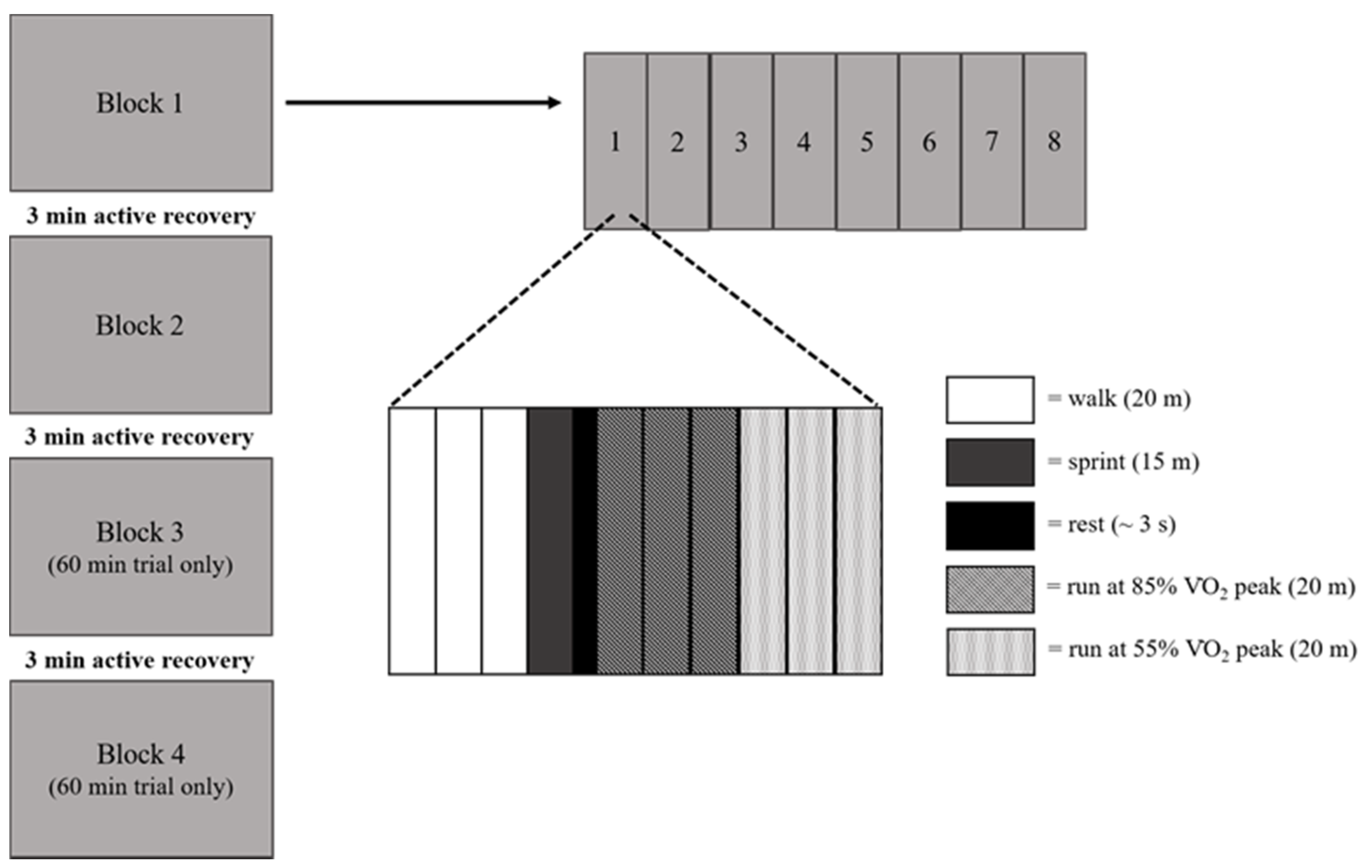
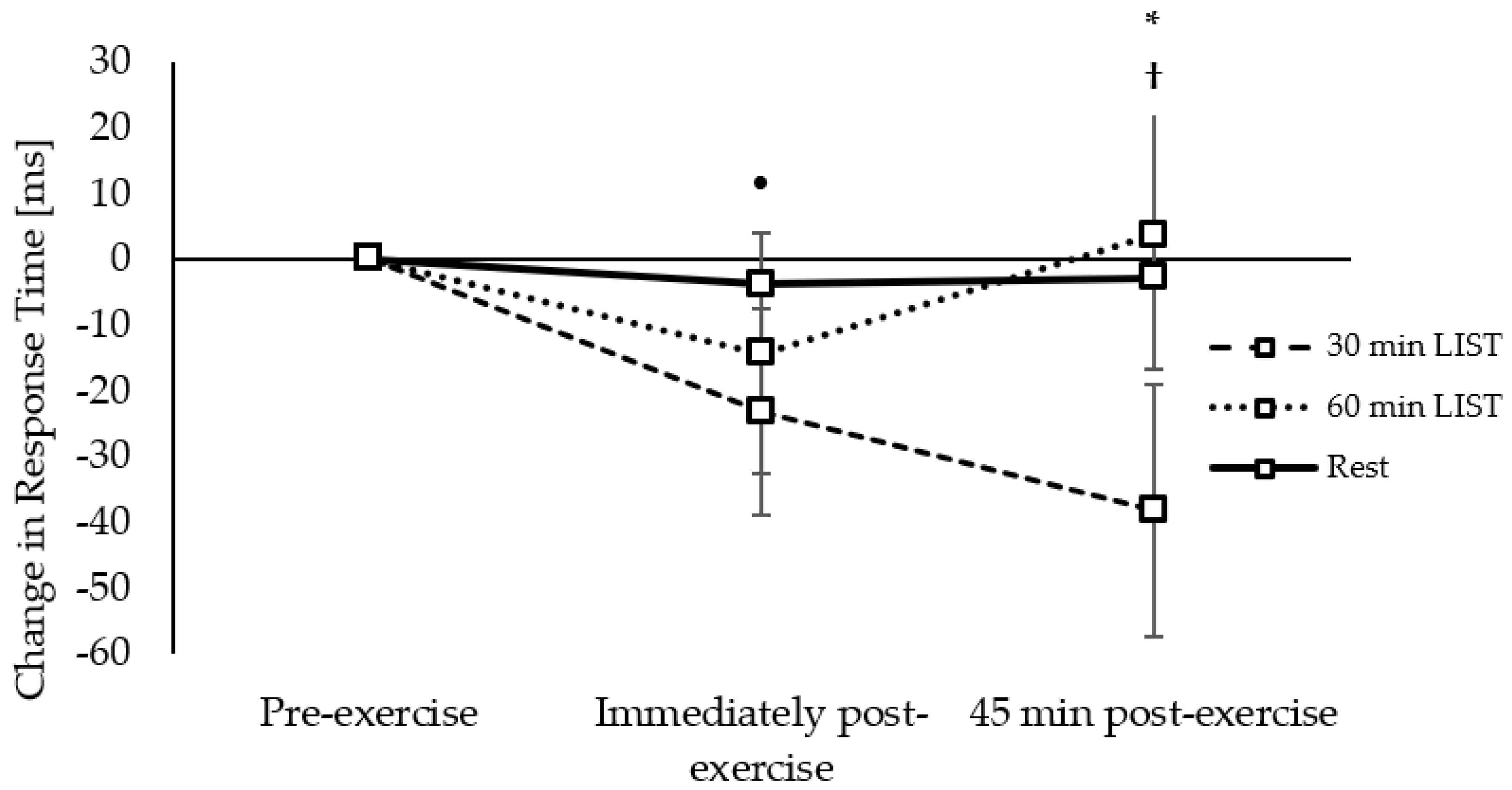
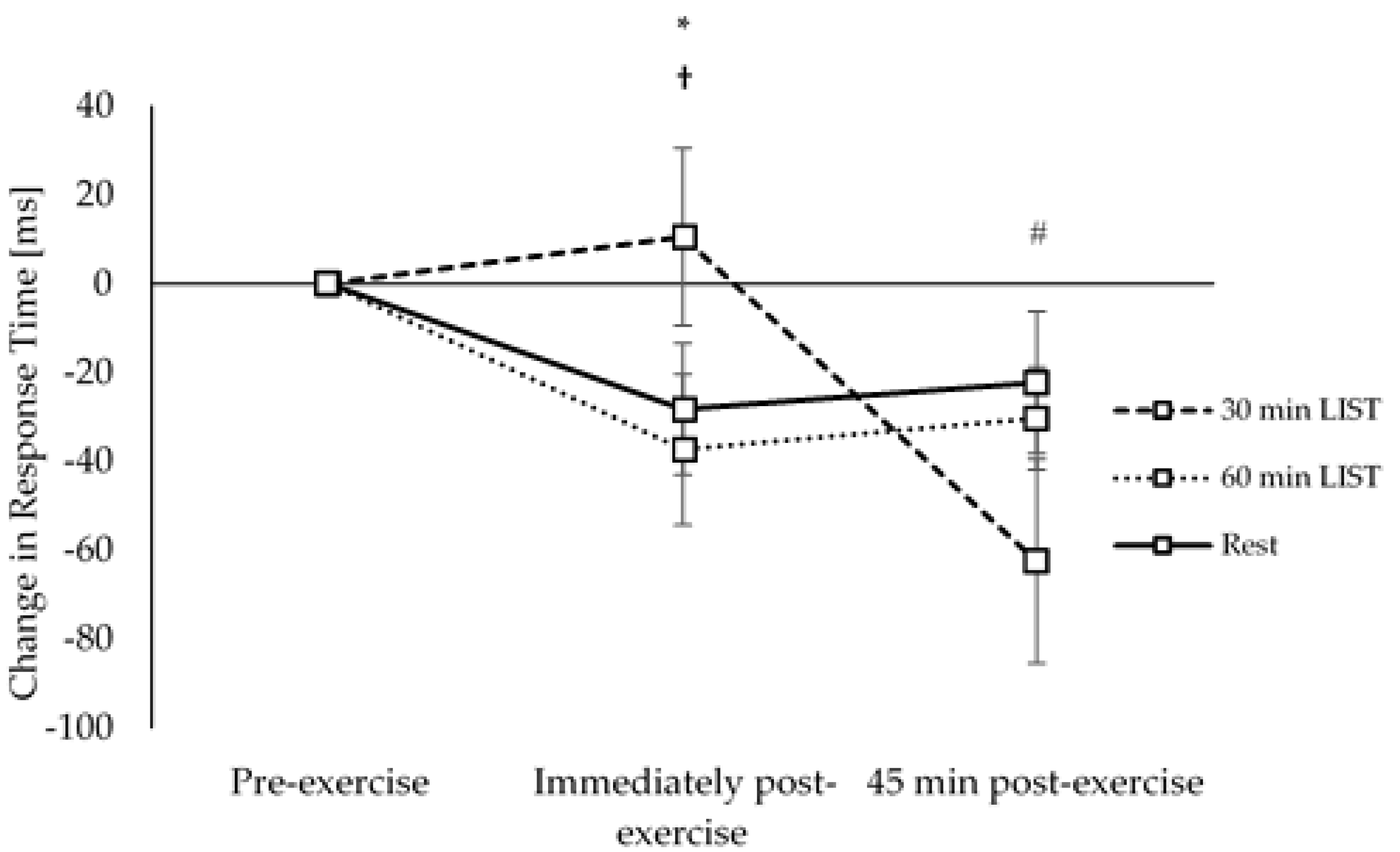
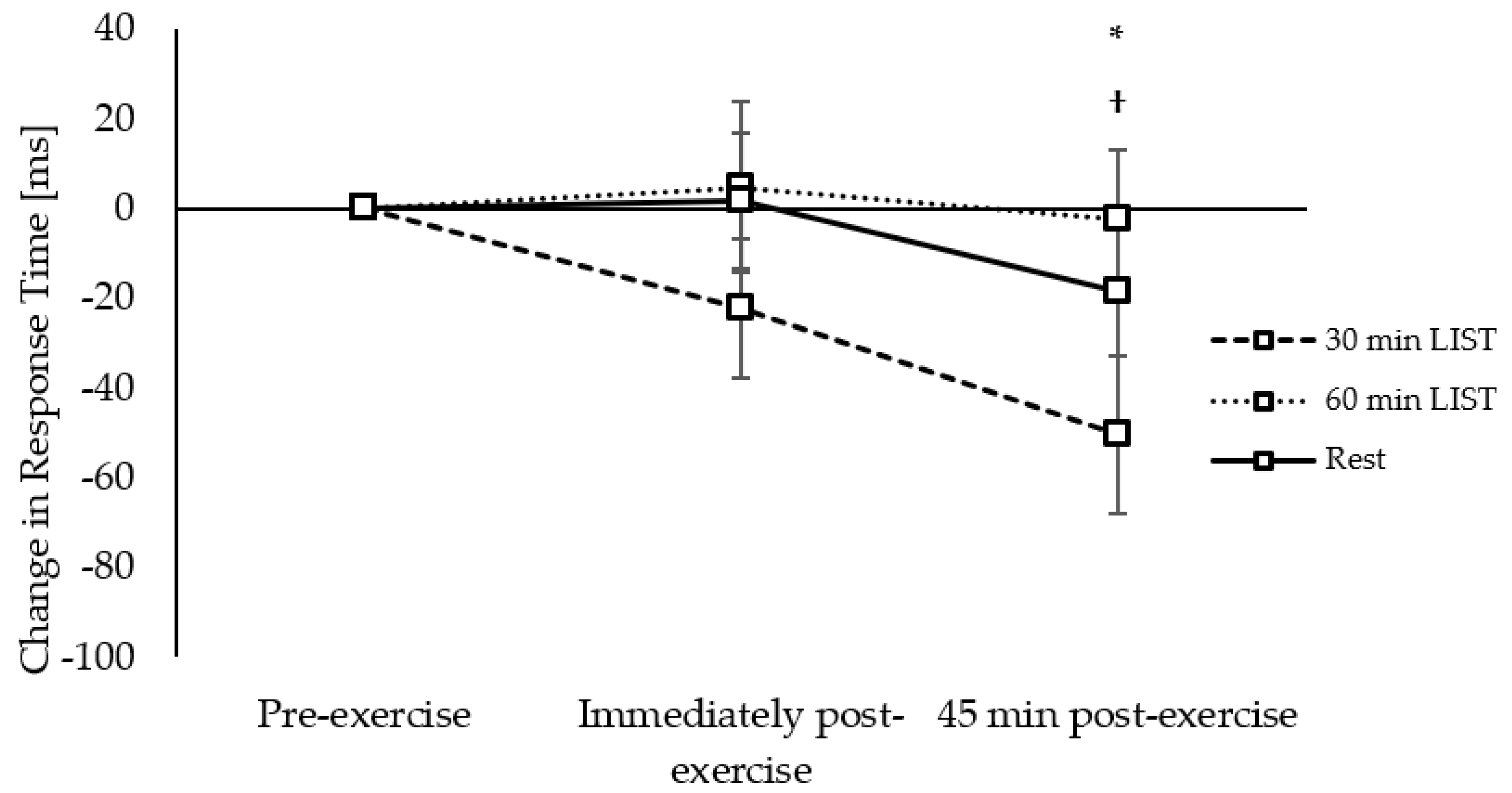
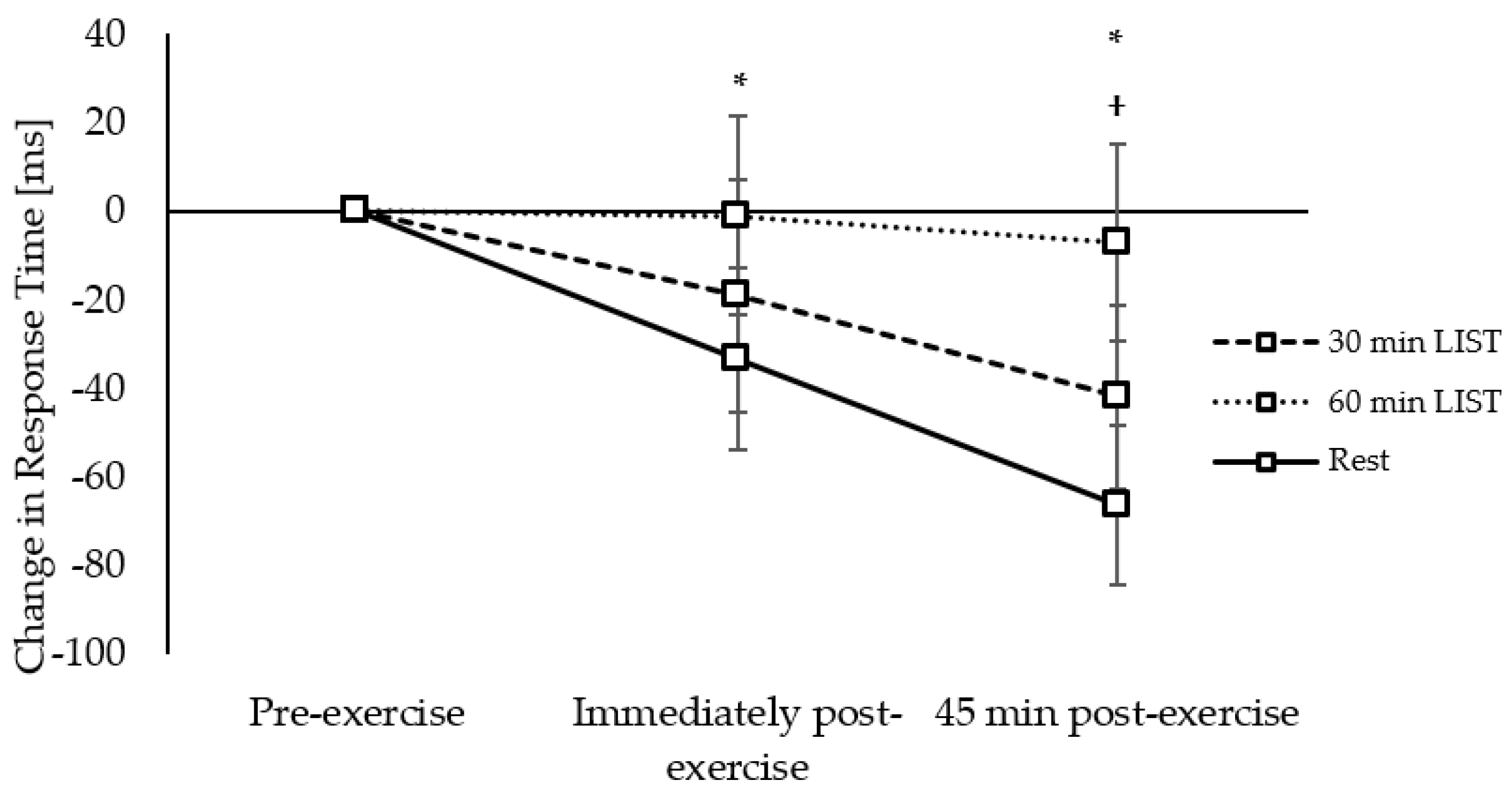
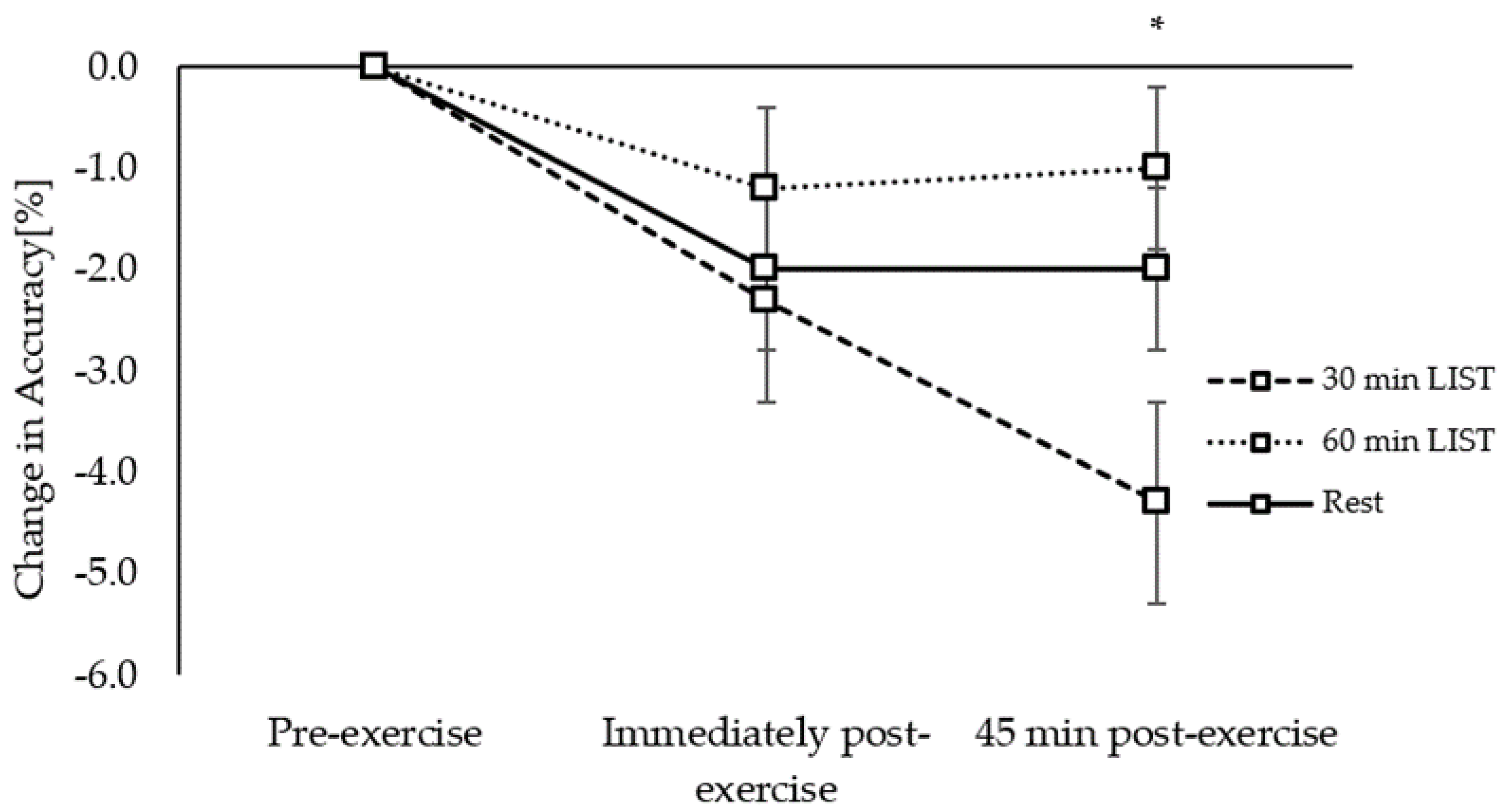
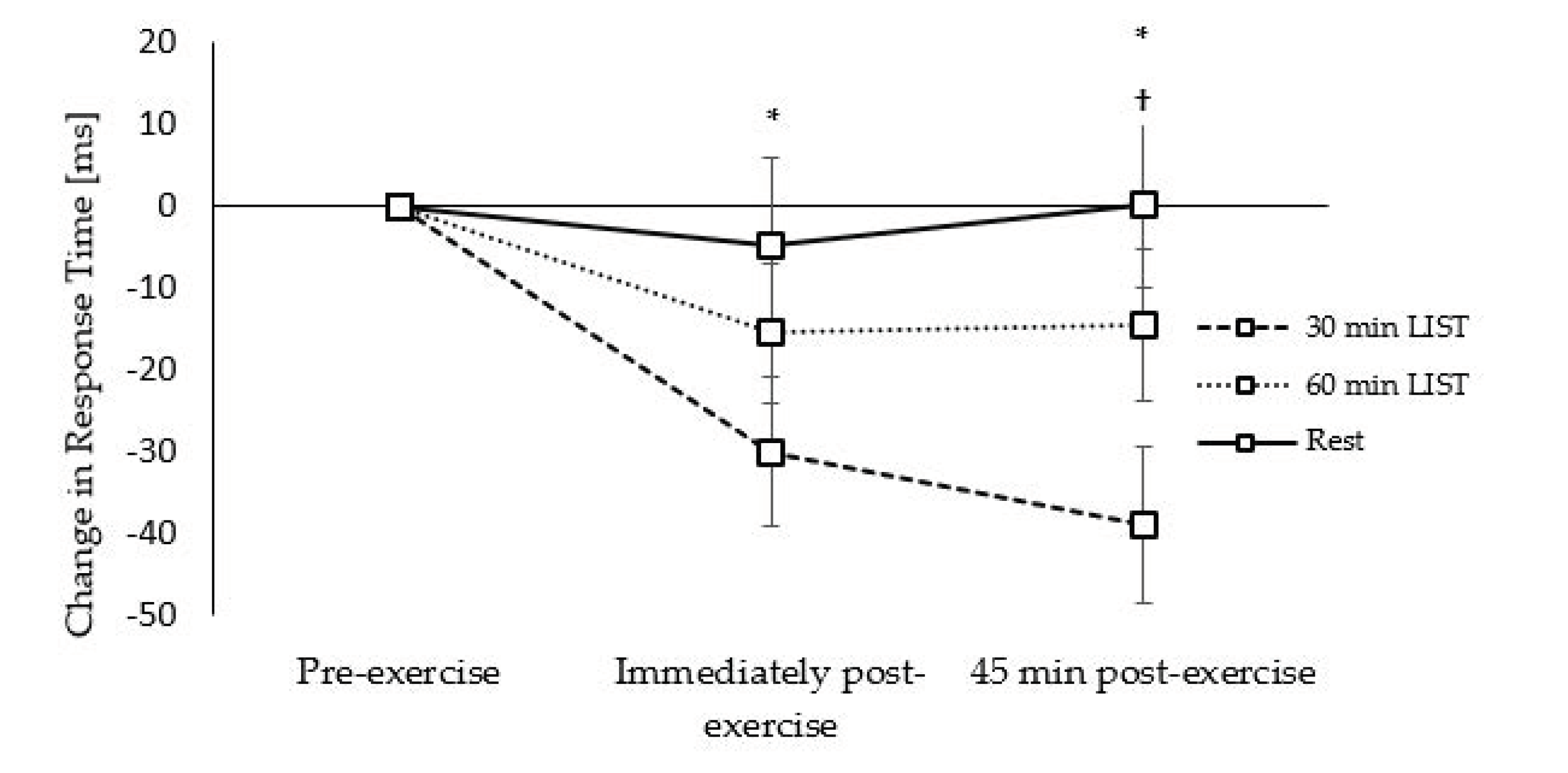
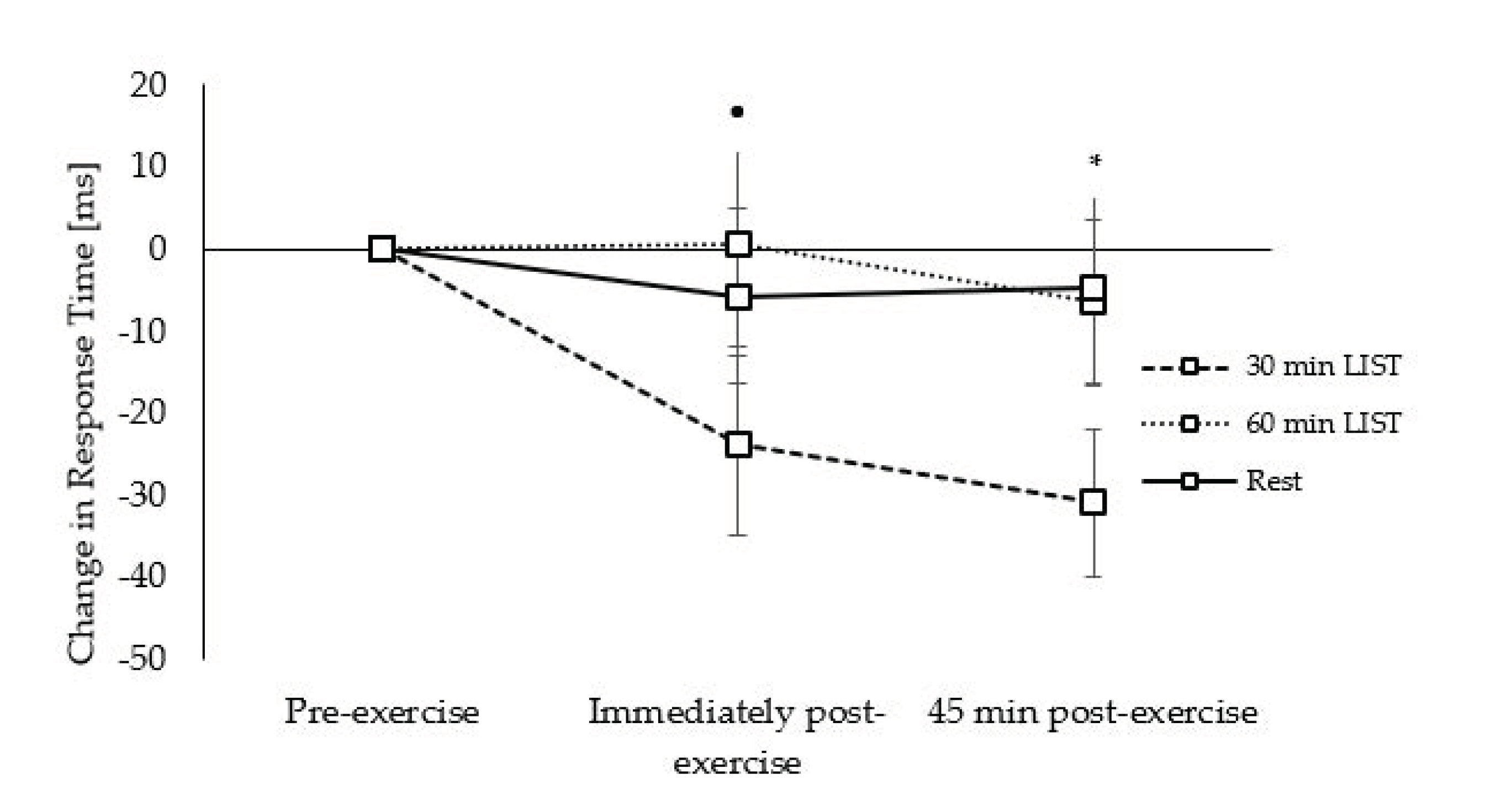
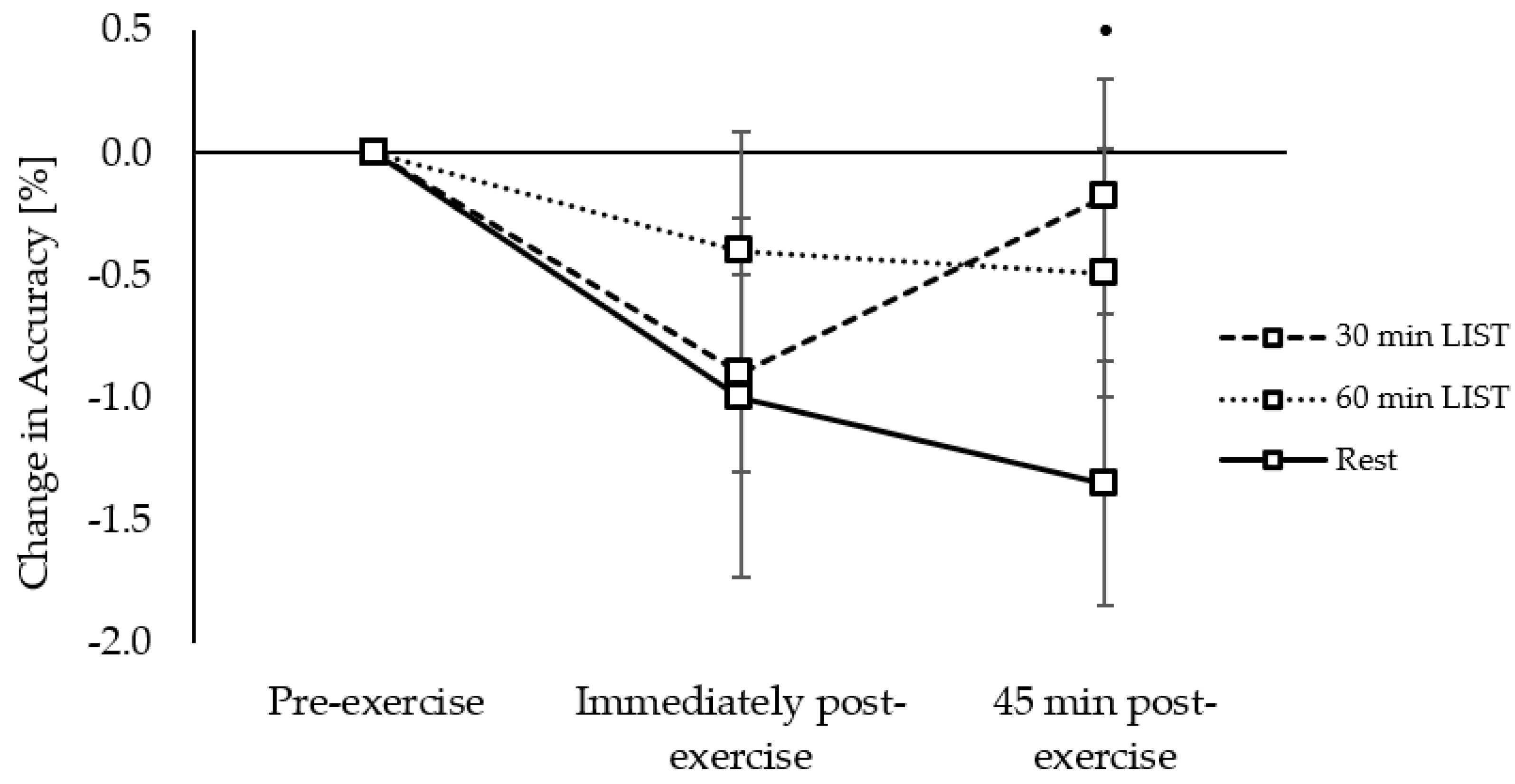
| Overall (n = 38) | Boys (n = 15) | Girls (n = 23) | p-Value a | |
|---|---|---|---|---|
| Age (yrs) | 12.4 ± 0.4 | 12.3 ± 0.5 | 12.4 ± 0.4 | 0.507 |
| Height (cm) | 157.7 ± 7.5 | 155.9 ± 9.1 | 159.0 ± 6.2 | 0.227 |
| Body mass (kg) | 45.0 ± 7.2 | 44.2 ± 7.5 | 45.5 ± 7.1 | 0.573 |
| Maturity offset (yrs) b | −1.4 ± 0.6 | −1.8 ± 0.4 | −1.2 ± 0.6 | 0.236 |
| Waist circumference (cm) | 65.0 ± 4.9 | 64.5 ± 4.2 | 65.4 ± 5.4 | 0.580 |
| Sum of skinfolds (mm) | 44.5 ± 13.7 | 39.9 ± 9.4 | 47.5 ± 15.4 | 0.097 |
| Test | Level | Variable | 30 min Exercise Trial | 60 min Exercise Trial | Resting | ||||||
|---|---|---|---|---|---|---|---|---|---|---|---|
| Pre | Immediately Post | 45 min Post | Pre | Immediately Post | 45 min Post | Pre | Immediately Post | 45 min Post | |||
| Stroop test | Simple | Response times (ms) | 741 ± 19 | 717 ± 24 | 703 ± 22 | 732 ± 21 | 718 ± 26 | 736 ± 24 | 727 ± 22 | 723 ± 24 | 724 ± 22 |
| Accuracy (%) | 98.4 ± 0.5 | 96.2 ± 0.8 | 97.0 ± 0.8 | 97.6 ± 0.6 | 96.2 ± 0.8 | 95.7 ± 0.9 | 97.3 ± 0.5 | 96.0 ± 0.7 | 95.4 ± 1.3 | ||
| Complex | Response times (ms) | 1009 ± 34 | 974 ± 37 | 955 ± 34 | 1019 ± 36 | 971 ± 39 | 972 ± 44 | 1003 ± 37 | 952 ± 39 | 964 ± 39 | |
| Accuracy (%) | 95.4 ± 0.6 | 95.7 ± 0.8 | 94.5 ± 1.1 | 95.9 ± 0.5 | 94.6 ± 0.7 | 94.4 ± 0.7 | 95.1 ± 0.6 | 93.4 ± 1.1 | 93.7 ± 1.3 | ||
| Sternberg paradigm | One-item | Response times (ms) | 531 ± 19 | 541 ± 21 | 468 ± 15 | 529 ± 19 | 491 ± 22 | 499 ± 22 | 511 ± 17 | 483 ± 19 | 489 ± 16 |
| Accuracy (%) | 97.2 ± 1.0 | 97.0 ± 1.0 | 94.4 ± 1.0 | 97.3 ± 1.0 | 97.0 ± 1.0 | 96.2 ± 1.0 | 96.9 ± 1.0 | 95.6 ± 1.0 | 95.6 ± 1.0 | ||
| Three-item | Response times (ms) | 672 ± 17 | 650 ± 17 | 621 ± 16 | 663 ± 20 | 668 ± 30 | 660 ± 36 | 647 ± 20 | 649 ± 19 | 629 ± 21 | |
| Accuracy (%) | 97.3 ± 0.6 | 95.0 ± 0.9 | 93.3 ± 0.7 | 96.1 ± 0.6 | 94.8 ± 0.7 | 95.0 ± 0.7 | 96.7 ± 0.6 | 94.7 ± 0.7 | 94.7 ± 0.9 | ||
| Five-item | Response times (ms) | 831 ± 25 | 812 ± 24 | 789 ± 17 | 808 ± 28 | 807 ± 30 | 801 ± 31 | 823 ± 23 | 789 ± 22 | 757 ± 22 | |
| Accuracy (%) | 94.7 ± 0.8 | 91.6 ± 1.1 | 91.9 ± 1.0 | 93.8 ± 0.8 | 92.1 ± 1.2 | 92.3 ± 1.1 | 92.5 ± 1.1 | 91.5 ± 1.0 | 89.9 ± 1.8 | ||
| Flanker task | Congruent | Response times (ms) | 559 ± 15 | 529 ± 14 | 521 ± 14 | 567 ± 19 | 552 ± 21 | 553 ± 21 | 548 ± 15 | 544 ± 18 | 549 ± 17 |
| Accuracy (%) | 98.9 ± 0.3 | 98.0 ± 0.5 | 98.7 ± 0.3 | 98.7 ± 0.3 | 98.3 ± 0.5 | 98.2 ± 0.4 | 99.2 ± 0.3 | 98.2 ± 0.8 | 97.9 ± 0.6 | ||
| Incongruent | Response times (ms) | 587 ± 13 | 563 ± 15 | 556 ± 15 | 592 ± 20 | 593 ± 21 | 586 ± 20 | 587 ± 16 | 581 ± 20 | 582 ± 17 | |
| Accuracy (%) | 95.8 ± 0.6 | 95.4 ± 0.7 | 94.0 ± 0.9 | 95.6 ± 0.6 | 94.5 ± 0.8 | 95.3 ± 0.7 | 95.9 ± 0.6 | 93.9 ± 0.7 | 94.7 ± 0.9 | ||
Publisher’s Note: MDPI stays neutral with regard to jurisdictional claims in published maps and institutional affiliations. |
© 2021 by the authors. Licensee MDPI, Basel, Switzerland. This article is an open access article distributed under the terms and conditions of the Creative Commons Attribution (CC BY) license (https://creativecommons.org/licenses/by/4.0/).
Share and Cite
Hatch, L.M.; Dring, K.J.; Williams, R.A.; Sunderland, C.; Nevill, M.E.; Cooper, S.B. Effect of Differing Durations of High-Intensity Intermittent Activity on Cognitive Function in Adolescents. Int. J. Environ. Res. Public Health 2021, 18, 11594. https://doi.org/10.3390/ijerph182111594
Hatch LM, Dring KJ, Williams RA, Sunderland C, Nevill ME, Cooper SB. Effect of Differing Durations of High-Intensity Intermittent Activity on Cognitive Function in Adolescents. International Journal of Environmental Research and Public Health. 2021; 18(21):11594. https://doi.org/10.3390/ijerph182111594
Chicago/Turabian StyleHatch, Lorna M., Karah J. Dring, Ryan A. Williams, Caroline Sunderland, Mary E. Nevill, and Simon B. Cooper. 2021. "Effect of Differing Durations of High-Intensity Intermittent Activity on Cognitive Function in Adolescents" International Journal of Environmental Research and Public Health 18, no. 21: 11594. https://doi.org/10.3390/ijerph182111594
APA StyleHatch, L. M., Dring, K. J., Williams, R. A., Sunderland, C., Nevill, M. E., & Cooper, S. B. (2021). Effect of Differing Durations of High-Intensity Intermittent Activity on Cognitive Function in Adolescents. International Journal of Environmental Research and Public Health, 18(21), 11594. https://doi.org/10.3390/ijerph182111594








